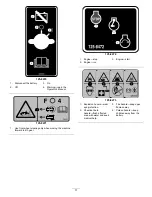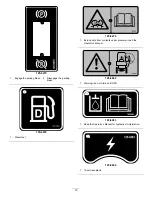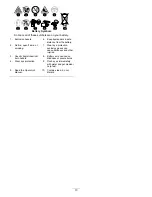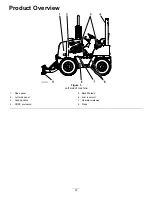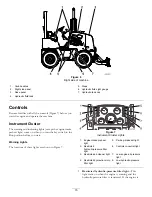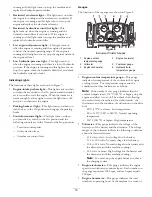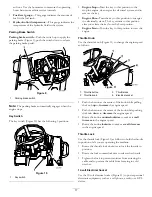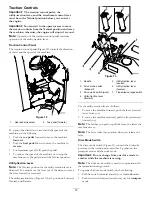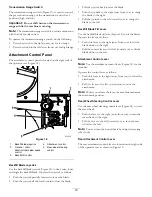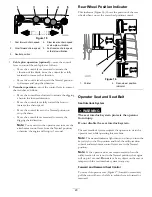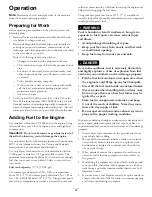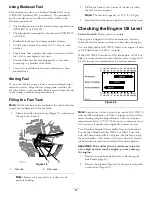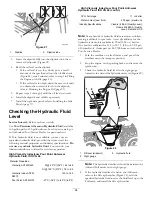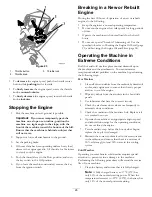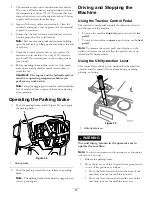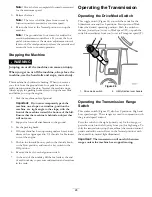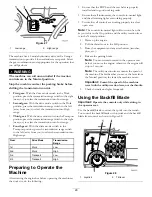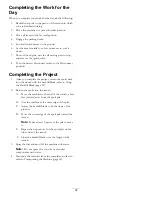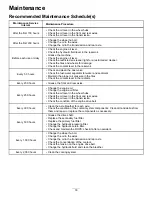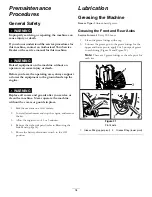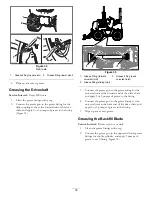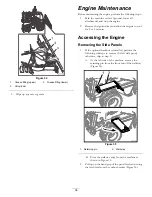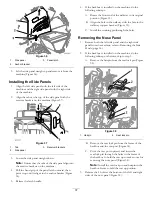
Inspecting the Machine Daily
Inspect the following items on the machine each day before
you start the engine:
•
Check for leaks under the machine, and repair all leaks.
•
Check the tires for wear, damage, and low pressure.
•
Check the machine for debris, especially around the
engine.
Note:
Ensure that the area near the engine is clean so
that the engine cools properly.
•
Clean or replace any safety or instructional decal that
cannot be read.
•
Clean machine components that you, the operator, use.
•
Remove any loose items from the machine.
•
Check the machine for broken, damaged, loose, or
missing parts. Replace, tighten, or adjust these parts
before you operate the machine.
•
Repair or replace all damaged ROPS and seat belt parts.
Starting the Engine
WARNING
Before starting the engine, sit in the operator seat,
fasten the seat belt, apply the parking brake, and
ensure that the transmission direction control and
digging control levers are in the Neutral position.
Warn all persons around you that you are starting
the engine.
Note:
The seat interlock system prevents you from starting
and operating the machine unless your are sitting in the
operator seat. If you do not remain seated and the control
levers are not in the Neutral position, the system will stop
both the ground drive and the attachment drive in 1 second.
Do not set a weighted object on the seat, bypass the seat
interlock system, or tamper with the system.
1.
Check the oil level; refer to Checking the Engine Oil
Level (page 23).
2.
Ensure that the battery-disconnect switch is in the On
position.
3.
Adjust the seat position and fasten the seat belt.
Note:
Ensure that the seat is facing forward.
4.
Set the parking brake switch to the On position.
5.
Ensure that all control levers are in the Neutral or the
Stop position and that the hand throttle is in the Idle
position.
The controls-in-neutral light will illuminate.
Note:
If the machine is equipped with a backhoe,
ensure that the engine shutoff control is pulled up.
6.
Pull the throttle lever out to the 1/2 Throttle position.
Note:
In extreme hot or cold weather, take the
necessary precautions; refer to Operating the Machine
in Extreme Conditions (page 26).
7.
Turn the key switch to the On position, and check that
the controls-in-neutral, the parking-brake warning, and
the oil-pressure warning lights illuminate.
Note:
The engine comes with an glow plug air
system that sense the inlet air temperature. If the air
temperature is cold, the wait-to-start warning light
alerts the operator to wait for the intake air to warm up
before starting. When the intake air is at the proper
temperature for starting the engine, the warning light
turns off.
8.
Turn the key switch halfway between the On and
Start positions, and check that the warning lights on
the instrument cluster are working properly; refer to
Instrument Cluster (page 15).
9.
Turn the key switch to the Start position.
Note:
If the engine starts and then stops,
do not
turn the key switch to the Start position again until the
starter motor has stopped turning.
Important:
Do not
operate the starter motor until
it stops turning.
Do not
operate the starter motor
for more than 30 seconds at one time. Allow the
starter motor to cool for 30 seconds before you
operate it again. When you engage the starter
motor, you should see white or black smoke
coming from the exhaust pipe; if you do not, check
the fuel supply.
10.
When the engine starts, check the instruments to
ensure that the gauge readings are correct. If any of
the warning lights turn on, stop the engine and check
the problem.
11.
Run at the engine at 1000 rpm until the coolant is
warm.
12.
Cycle all the machine components before operating the
machine, and check all the controls and components to
ensure that they are working properly.
Note:
If the engine is new or newly rebuilt, refer to
Breaking in a New or Rebuilt Engine (page 26).
Setting the Engine Speed
Note:
Do not
run the engine at a low idle speed for long
periods of time, because it causes a low operating temperature
that can allow acids and deposits to form in the engine oil.
Note:
For maximum life and machine performance, operate
the engine at full throttle whenever the conditions allow you
to safely do so.
•
To
increase
the engine speed, push the throttle center
button while
pulling out
the throttle (Figure 23).
25
Содержание RT600
Страница 71: ...Notes 71...

